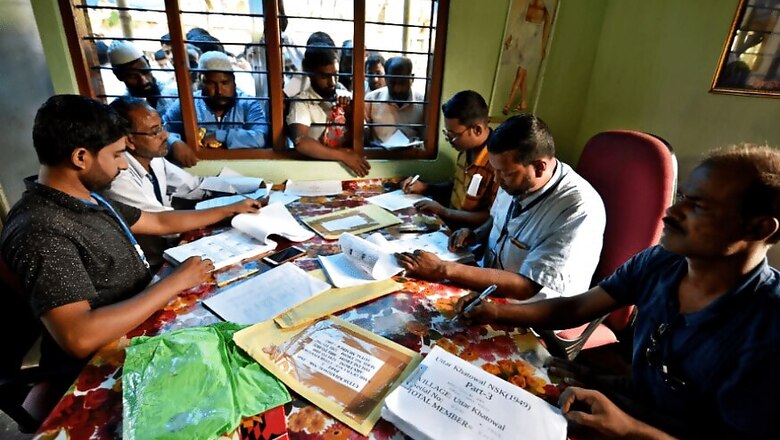
views
New Delhi: The state of Assam has twice forced major changes in India’s citizenship framework in defense of illegal immigration from Bangladesh. The Citizenship Act of 1955 identified an Indian citizen on the basis of birth. This framework moved towards a more exclusionary principle with the 1986 and 2003 amendments to the Act granting citizenship by blood-based descent.
The 1986 amendment to the Citizenship Act – for the first time – openly associated migration with “illegality” while setting the condition of Indian descent. On the other hand, the 2003 amendment strengthened this association by simultaneously distinguishing between the legality of de-territorialised diaspora - by providing Overseas Indian Citizenship (OCI) - against the illegality of the territorialised migrant.
India launched its democracy with the preparation of its electoral rolls and Census in 1951. The Citizenship Act came into effect five years later. Thus, the electoral roll became a significant document of evidentiary proof of identity even before law identified and defined citizenry. Assam’s anti-immigrant movement demanded the revision of this document.
The political regimes of Assam at the behest of the 1979-85 Assam Movement against illegal immigration amended the constitution to define the legal status of citizenship as a recognised identity, replacing the burden of proof from an electoral document.
The determination of citizenship, the ‘Assamese’ middle-class recognised, was the all-encompassing to-be achieved ‘status’: with the right to individual freedom, the right to participate in the exercise of political power and the right to security and share in social heritage, to consolidate their identity. The sentiment of strengthening the idea of state membership emerged against the resentment of Bengali cultural supremacy in the state during British Raj.
Within this historical context, the exercise of the National Register of Citizens (NRC) for over 50 years has re-invented citizenship in Assam as the ‘to-be achieved status’ of state membership – by proof of domicile – to consolidate an Assamese identity. Illegal immigrants are to be denied this status. They are to be denied a cultural recognition and rights.
However, their detection plays an indispensable role in identifying “genuine” Indian citizens.
News18 discusses three aspects of citizenship in Assam that may disrupt India’s citizenship discourse in the aftermath of the NRC.
Legacy
Assam has pushed for a paradigm shift in narrowing claims to citizenship in India, for the detection and deletion of its illegal immigrants. Indian citizenship, thus, is progressively restricted by birth, but conditional and contingent on Indian ‘origin’.
Establishing proven legacy to the state of Assam through an ancestor with Assam domicile before 24 March 1971 is a requisite for registration in the NRC. Tracing an Assamese legacy for Indian citizenship is problematic because it formulates a national identity based on local inheritance.
The concerns of this local inheritance are contingent on the migrant influx into Assam that resulted out of the 1947 Indian Partition and the liberation of a Bengali Muslim majority Bangladesh from Pakistan in 1971.
A “genuine” citizen of Assam, therefore, emerges from a problematic legacy that narrowly defines Indian origin only as a domicile in Assam. Given this conditionality, the moral claims of many as denizens of Assam go unwarranted without proof of domicile. Their status is termed ‘illegal’, while parentage – even if Indian – becomes disputable and insufficient.
Currently, 4.1 million NRC defaulters are in a state of limbo: between re-appealing claims to Indian citizenship and uncertain socio-political rights. The pathology of anxiety in Assam is the migrant inhabiting the wrong markers of citizenship – Bengali, Muslim, Bangladeshi or ‘non-existent in State records’.
If the NRC were to be implemented in any other state in the country, Assam’s experience of the exercise encourages proof of domicile as a leading category to prove state membership. Proof of domicile would also lead to a cementing of regional identities based on documentary evidence.
The need to establish a legacy to the land will term illegal the many migrants from other states, forcing him/her to return to their land. What if, a person does not hold any documents of domicile? What would India look like if citizenship is contingent on state legacy? What may be the consequences of a stronger regional identity based on geographic legacy, given most states are already divided linguistically?
Duality
India’s plural society often battles between two claims to citizenship: universal and differentiated. Universalist claims recognise individuals as the bearers of equal rights. Differentiated claims, on the other hand, attempt to bridge inequalities of group identity overlooked by the Universalist tradition. Symbolic recognition of reserved quotas reduce these inequalities by providing a differentiated ‘status’.
Citizenship in India was negotiated into a group-differentiated tradition, from a Universalist one, academic Niraja Jayal has argued, as an “antidote” to the majoritarianism (faced by Muslims), discrimination (against Scheduled Castes) and backwardness (experienced by indigenous communities) in India.
The NRC is an instrument for group-differentiated citizenship (GDC) regime in Assam on the claims that Assamese culture is vulnerable to marginalisation against a growing number of illegal immigrants. What problematises this claim is the fact that Assamese is the dominant culture in the state.
In Assam, NRC is expected to homogenise identity rather than bridge inequalities. The project constructs a permanent majority of Assamese, and minority Muslim and Bengali identity in Assam thereby dismantling democracy’s secular principle. The democratic space for Muslims shrinks as a result. Then, a duality in India’s citizenship discourse would emerge; a hostility between state aspirations to exclude and national ambitions to recognise certain groups.
Following the NRC, what does the future of the minority communities in India look like? What may be the consequences of overlooking democratic values of the Indian constitution and the rights of Muslims in Assam, for India’s larger population mix?
Deception
The BJP government in Delhi, in another scheme of events, is also attempting a new citizenship regime that opposes its smaller GDC projects. In 2016, a new amendment to the Citizenship Act was proposed. The amendment Bill provides “citizenship to illegal immigrants” from select countries, who identify as Hindu, Sikh, Buddhist, Jain, Parsi or Christian.
Bill is a threat to minority communities. The NRC does not distinguish illegal immigrants on the basis of religion, whereas the Bill is designed to exclude Muslims and include Hindus. In Assam, it threatens to minoritize the indigenous population by absorbing a Hindu population– against the aims of the NRC.
In NRC discourse, the expression “originally inhabitants of the state of Assam”, the Supreme Court of India has ruled, is only a category to identify persons “entitled” to be included in the Register under a “less strict” process. However, indigeneity as the basis for “entitlement” is problematic, argues African Post-Colonial intellectual Mahmood Mamdani, because it compels the group to establish an ethnic home.
An opposition between Assam’s GDC and India’s proposed citizenship design exposes regional and national caveats in citizenship.
A duality in India’s citizenship framework renders legitimate a “genuine” citizen’s claim of “original” inhabitancy based on domicile – contested claim in a multi-ethnic state. They are “original” as far as they are “genuine” i.e. since India’s independence by proof of domicile.
India’s current citizenship design mediates the citizen-state relationship in Assam on the poetics and politics of an anti-immigrant discourse that recognises the Assamese legacy for “genuine” Indian citizenship. The proposed change in the citizenship design would hold superior a subgroup of “genuine” citizens – the Hindu Assamese.
The non-Hindu Assamese will be subjected to differentiated superior and thereby inferior citizenship status, in practice. The pathology of anxiety will then turn to be a non-migrant inhabiting the “wrong” religion.
This forthcoming regime of citizenship may inflict distress in this largely indigenous state, asking: why are Hindu Assamese the only claimants to “original” inhabitancy? With the minorities subjected to discrimination, and a section of the majoritarian group suspect to possible social inferiority, will Assam in the coming years be able protect its current sectarian peace from a previous high point?




















Comments
0 comment